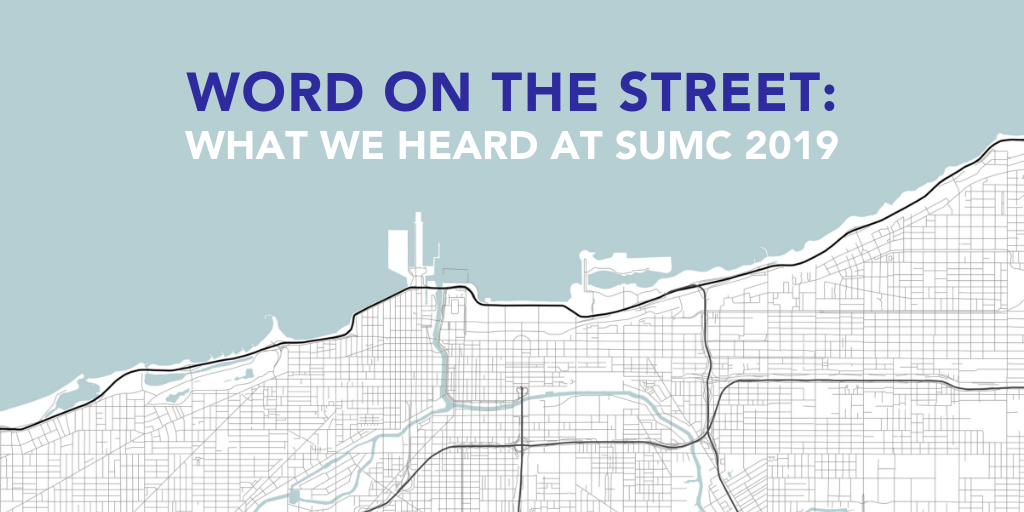
Earlier this month our team traveled to Chicago, IL for the 2019 National Shared Mobility Summit. Every year the Summit brings together mobility leaders who are exploring options to create a multi-modal transportation solution to enhance their communities. This year, 700 mobility experts from 40 States and 14 countries gathered to ask the tough questions and make moves towards real solutions.
Here are the 7 key takeaways gathered from sessions and conversations had in the Windy City:
1. As technology advances our transportation needs to advance with it.
There are many things that need to be reimagined now that we have an ever-increasing number of services and devices on the streets of our cities. In the spirit of sharing our streets and cities, we will need to reconsider both how our cities are designed and how the laws and regulations—such as who has the “right of way”—keep people safe as they move from place to place. Technology has advanced at a rapid pace over the last decade and transit leaders are calling for agencies to innovate and disrupt the status quo to keep up.
2. Public transportation needs to be available for all.
Transportation is a need for all regardless of income, geographic areas, or disabilities. The panel, Inclusive Shared Mobility and People with Disabilities: Strategic and Regulatory Approaches”, discussed what supportive policies and strategies have worked, potential roadblocks, and remaining gaps and opportunities with meeting the needs of people with disabilities. Public transit needs to be central to mobility as it is a service to the public.
3. Data is power.
When it comes to new projects and services, data is a necessity for decision-making. If agencies can gather the relevant data, it gives them the power to innovate and empower their communities. While some private companies are leery to share information, being transparent with data helps advance mobility service for all.
4. Efficiency over price.
Commuters are more interested in an efficient transportation experience than always choosing the cheapest option. This makes multi-modal an attractive option for riders and agencies alike, as they can use the most logical transportation options to get where they need to go. For example, if they are getting from the suburbs to downtown, they can take a TNC to get to the bus, take the bus downtown, then use a scooter or bike for the last leg of their trip.
5. Shared Mobility and Alternative modes of transportation are picking up momentum and actually being tested, not just talked about!
Hundreds of agencies are searching for or already conducting projects to test new services based on findings from the pre-conference workshop Mobility On Demand On-Ramp. This includes bikes, scooters, skateboards, and microtransit, among others.
6. Risk-Sharing is a major component of the Public-Private-Partnership.
When it comes to public-private-partnerships (P3s), there isn’t a playbook or guide to go by. Despite the unknowns when implementing new services, public transit agencies are embracing the challenge by looking at small pilot options before committing to anything long term. The private sector should help agencies by assessing the risks up front to mitigate as much as possible. While risk-sharing will always be a part of the P3, successful partnerships start when both sectors acknowledge the risks up front.
7. Public transit agencies learned goal flexibility is key when testing new tech and modes of transportation.
While a project may start to solve one set of problems, goals may change as service scales and new problems are identified. Developing new goals can start by observing what other agencies are doing, but there is no one size fits all solution. We are witnessing more agencies adopt flexibility into their pilot programs as they learn from one another during these trial phases. Flexibility is the key to success.
45% of Americans have no access to transportation. Public transit agencies are on a mission to serve the population and not only make public transportation an accessible option, but an appealing one as well. As the market continues to evolve with new technologies and changing demands, industry leaders are collaborating and adapting to better serve their communities. The Shared Mobility Summit made one thing clear: with the right data, strategic partnerships, and new technology, we can truly make public transportation the first choice for all.
Did you attend the National Shared Mobility Summit? Share your insights and takeaways in the comments below!
For more information on microtransit, download our latest white paper today!